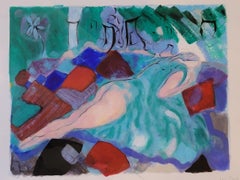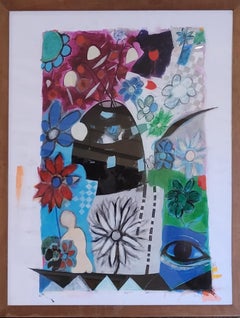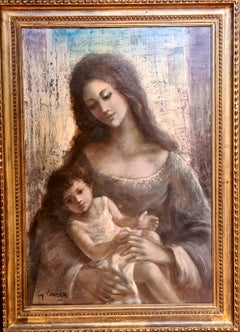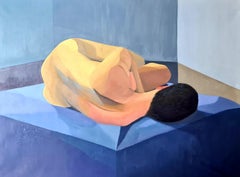About La Galerie Cotignac
For over 20 years Simon and John have been sourcing and selling fine art, antiques, items of design, antique furniture and collectables to a discerning international clientele. Based in the South of France they have 2 galleries dealing in items from the 17th to the 21st century, antique, vintage, mid-century, contemporary and modern. They are happy to advise and help in the formation of collections or in finding that perfect piece to complete a project or to offer as a special celebratory gift.

Established in 20001stDibs seller since 2020
Featured Pieces
Contemporary Colorful Female Nude in Repose in Acrylic and Pastel.
Located in Cotignac, FR
Contemporary Colorful nude in Repose by French artist Gérard Israel. Presented in a wooden frame under glass.
This intriguing artwork captures the viewer with its vivid use of color...
Category
21st Century and Contemporary Figurative Paintings
Materials
Oil Pastel, Acrylic
Contemporary Colorful Abstract Acrylic and Pastel. Still-Life of Flowers.
Located in Cotignac, FR
A contemporary abstract still-life of flowers in a vase by French artist Gérard Israel. Presented in a wooden frame under glass.
This vibrant artwork masterfully combines mixed medi...
Category
21st Century and Contemporary Abstract Paintings
Materials
Oil Pastel, Acrylic
Mother and Child, Ecole de Paris, Large Oil on Canvas
By Guy Cambier
Located in Cotignac, FR
Ecole de Paris, mid century oil on canvas portrait of a mother and child by Guy Cambier. The painting is signed bottom left and there is a very faint chalk inscription with date to t...
Category
Mid-20th Century Romantic Figurative Paintings
Materials
Canvas, Oil
Colourful Large Cubist Nude, Nue Allongée
Located in Cotignac, FR
Colourful, large, modern Cubist oil on canvas nude by Isabelle Pardoe. The painting is not signed but came directly from the atelier of the artist.
Isabell Pardoe trained at the Sl...
Category
Late 20th Century Modern Nude Paintings
Materials
Oil, Acrylic, Canvas
Colourful Large Female Nude, Femme Nue Allongée
Located in Cotignac, FR
Colourful, large oil on canvas female nude by Isabelle Pardoe. The painting is not signed but came directly from the atelier of the artist.
Isabell Pardoe trained at the Slade scho...
Category
Late 20th Century Modern Nude Paintings
Materials
Oil, Acrylic, Canvas
Colourful Modern French Landscape, The Roofs of St Tropez
Located in Cotignac, FR
Late 20th Century oil on canvas view of the colourful buildings and roofs in St Tropez, South of France, by Franco British artist Isabell Pardoe. The painting is not signed but came ...
Category
Late 20th Century Modern Landscape Paintings
Materials
Oil, Acrylic, Canvas
French Impressionist Landscape, Barbizon School, Crossing the River
Located in Cotignac, FR
Early 20th century watercolour on paper of a tranquil river, bridge and village scene. The painting is presented in a plain wood frame under glass.
This charming watercolour portra...
Category
Early 20th Century Impressionist Landscape Drawings and Watercolors
Materials
Watercolor, Gouache
Contemporary Abstract Expressionist, Color-Field Acrylic on Canvas.
Located in Cotignac, FR
A contemporary Abstract Expressionist Color-Field acrylic on canvas by French artist, Christian Manoury. Signed to the back of the canvas.
Inspired by the wonderful light in the Sou...
Category
21st Century and Contemporary Other Art Style Abstract Paintings
Materials
Canvas, Acrylic
Xexa Domb Offset Print, Bruckmann Series.
By (After) Victor Vasarely
Located in Cotignac, FR
Offset print, 'Xexa Domb' after Victor Vasarely (Bruckmann Series 1974) , signed in the plate (covered by the passepartout). Presented in a silver metal frame under glass.
This mesm...
Category
Mid-20th Century Op Art Abstract Prints
Materials
Offset
French Café Scene. 'La Taverne'. Watercolour on Paper..
Located in Cotignac, FR
Late 20th century watercolour of a French street scene with café by French artist Raymond Lacouture. Presented in a gold wooden frame under glass.
This artwork presents a vibrant, l...
Category
Late 20th Century Landscape Drawings and Watercolors
Materials
Watercolor
Paris, Montmartre In the Snow, Cabaret au Lapin Agile After Maurice Utrillo
Located in Cotignac, FR
Paris, Montmartre in the snow, the Cabaret au Lapin Agile favourite of Picasso, Modigliani and Utrillo, late mid century French oil on board by Jean Mesturini. The painting is signed...
Category
1970s Post-Impressionist Landscape Paintings
Materials
Oil
Hopi Katsina Doll in Carved Cottonwood.
Located in Cotignac, FR
A Native North American carved wood and painted effigy figure, Hopi Katsina or Kachina doll.
A wonderfully playful, coloured and highly individual Hopi Katsina doll. Each doll repr...
Category
Mid-20th Century Figurative Sculptures
Materials
Wood




